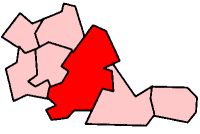Camp Hill, West Midlands
| Camp Hill | |
|---|---|
|
Church of the Holy Trinity | |
| Coordinates: 52°28′05″N 1°52′44″W / 52.468°N 1.879°WCoordinates: 52°28′05″N 1°52′44″W / 52.468°N 1.879°W | |
| Country | England |
| County | West Midlands |
| City | Birmingham |
Camp Hill is an area of Birmingham, West Midlands, England.[1]
The area's name was first recorded as Kempe Hill, derived from a family name, in 1511,[1] but it became known as Camp Hill after Prince Rupert set camp there in 1643, prior to the Battle of Camp Hill, during the English Civil War,[1] reputedly using the Ship Inn as his headquarters.[2]
The area is dominated by a former Commissioners' Church, the Church of the Holy Trinity, designed by Francis Goodwin in decorated perpendicular gothic stylle and built from Bath stone in 1820-1822.

Another notable local building is timber-framed Stratford House, built in 1601 and now a scheduled Ancient Monument and Grade II* Listed.[1]
The former King Edward VI Camp Hill School for Boys building is now a community centre; the school relocated to Kings Heath in 1956.
The area was formerly served by Camp Hill railway station, which closed in 1941. The Warwick and Birmingham Canal, part of the Grand Union Canal, passes though the area, with a set of six locks, known as Camp Hill Locks.
References
- 1 2 3 4 "Camp Hill". History of Birmingham Places & Placenames. Retrieved 10 May 2012.
- ↑ "The Old Ship Inn, Camp Hill". Birmingham City Council. Retrieved 10 May 2012.

